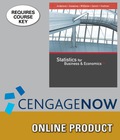
Kiplinger’s Personal Finance Magazine rated 359 U.S. metropolitan areas to determine the best cities to live, work, and play. The data contained in the data set named MetroAreas show the data from the Kiplinger study for the 50 metropolitan areas with a population of 1,000,000 or more (Kiplinger’s website, March 2, 2009). The data set includes the following variables: Population, Income, Cost of Living Index, and Creative (%). Population is the size of the population in 1000s; Income is the
- a. Develop a
scatter diagram for these data with median household income as the independent variable and the percentage of the workforce in creative fields as the dependent variable. Does a simple linear regression model appear to be appropriate? - b. Develop a scatter diagram for these data with the cost of living index as the independent variable and the percentage of the workforce in creative fields as the dependent variable. Does a simple linear regression model appear to be appropriate?
- c. Use the data provided to develop the best estimated multiple regression equation for estimating the percentage of the workforce in creative fields.
- d. The Tucson, Arizona, metropolitan area has a population of 946,362, a median household income of $42,984, and cost of living index of 99. Develop a prediction of the percentage of the workforce in creative fields for Tucson. Are there any factors that should be considered before using this predicted value?
Want to see the full answer?
Check out a sample textbook solution
Chapter 16 Solutions
CENGAGENOW FOR ANDERSON/SWEENEY/WILLIAM
- AP1.1 You look at real estate ads for houses in Sarasota, Florida. Many houses range from $200,000 to $400,000 in price. The few houses on the water, however, have prices up to $15 million. Which of the following statements best describes the distribution of home prices in Sarasota? The distribution is most likely skewed to the left, and the mean is greater than the median. The distribution is most likely skewed to the left, and the mean is less than the median. The distribution is roughly symmetric with a few high outliers, and the mean is approximately equal to the median. The distribution is most likely skewed to the right, and the mean is greater than the median. The distribution is most likely skewed to the right, and the mean is less than the median.arrow_forwardDuring busy political seasons, many opinion polls are conducted. In apresidential race, how do you think the participants in polls are generally selected?Discuss any issues regarding simple random, stratified, systematic, cluster, andconvenience sampling in these polls. What about other types of polls, besides political?arrow_forwardPlease could you explain why 0.5 was added to each upper limpit of the intervals.Thanksarrow_forward
- 28. (a) Under what conditions do we say that two random variables X and Y are independent? (b) Demonstrate that if X and Y are independent, then it follows that E(XY) = E(X)E(Y); (e) Show by a counter example that the converse of (ii) is not necessarily true.arrow_forward1. Let X and Y be random variables and suppose that A = F. Prove that Z XI(A)+YI(A) is a random variable.arrow_forward30. (a) What is meant by the term "product measur"? ANDarrow_forward
 Glencoe Algebra 1, Student Edition, 9780079039897...AlgebraISBN:9780079039897Author:CarterPublisher:McGraw Hill
Glencoe Algebra 1, Student Edition, 9780079039897...AlgebraISBN:9780079039897Author:CarterPublisher:McGraw Hill Big Ideas Math A Bridge To Success Algebra 1: Stu...AlgebraISBN:9781680331141Author:HOUGHTON MIFFLIN HARCOURTPublisher:Houghton Mifflin Harcourt
Big Ideas Math A Bridge To Success Algebra 1: Stu...AlgebraISBN:9781680331141Author:HOUGHTON MIFFLIN HARCOURTPublisher:Houghton Mifflin Harcourt Holt Mcdougal Larson Pre-algebra: Student Edition...AlgebraISBN:9780547587776Author:HOLT MCDOUGALPublisher:HOLT MCDOUGAL
Holt Mcdougal Larson Pre-algebra: Student Edition...AlgebraISBN:9780547587776Author:HOLT MCDOUGALPublisher:HOLT MCDOUGAL



